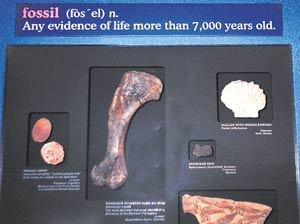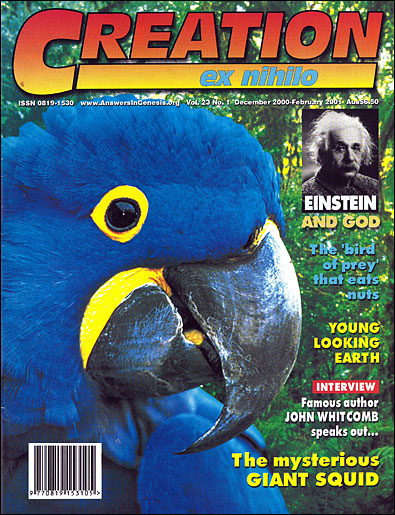Fossil folly
A misleading museum display seems to want to exclude the truth of Genesis ‘by definition’

Museum displays promoting evolution abound (see, for example, ‘Ape woman statue misleads public’, Creation 19(1):52, 1997). However, a fossil display at the Museum of Western Colorado’s Dinosaur Valley, USA, brazenly takes anti-biblical indoctrination to a new extreme. In large print (see photo), they have defined a fossil as ‘Any evidence of life more than 7,000 years old.’
In just a few words, this amazing definition dismisses the Genesis account of creation by simply defining it out of existence. By adding up the chronologies in the Bible, it is clear that all life (and indeed the entire heavens and earth) was created in six days, only six or seven thousand years ago. But according to this museum’s definition, any time you see a fossil, it is, by definition, evidence of life existing before then. Visitors to the museum could logically conclude, therefore, that the Bible must be wrong.
But scientific dictionaries and textbooks show the museum to be in error. Chambers Science and Technology Dictionary defines a fossil as ‘The relic or trace of some plant or animal which has been preserved by natural processes in rocks of the past.’1 No mention of 7,000 years there. Nor in The Hutchinson Dictionary of Science: ‘fossil (Latin fossilis ‘dug up’), remains of an animal or plant preserved in rocks’. Fossils may be formed by refrigeration (for example, Arctic mammoths in ice); carbonization (leaves in coal); formation of a cast (dinosaur or human footprints in mud); or mineralization of bones, more generally teeth or shells.’2 My undergraduate biology and geology textbooks3,4 similarly defined fossils as preserved evidence of organisms that lived in the past—without any stipulation whatever as to their minimum age.
So where did this figure of ‘7,000 years’ come from? It certainly has no basis in science. And it ignores the many examples of relics or traces of life that have been preserved in recent history.5
One could almost think that the ‘7,000 year’ figure was deliberately chosen to undermine the authority of Scripture. Certainly its effect would be to cause many people to doubt the Bible. Given the prevalence of such misleading museum displays, it is not surprising that Christians are warned to ‘test everything’ (1 Thessalonians 5:21) and not be taken captive by the deceptive philosophy and counsel of ungodly men (Colossians 2:8; Psalm 1:1).
Re-posted on homepage: 4 July 2018
References and notes
- Walker, P.M.B. [ed], Chambers Science and Technology Dictionary, W. & R. Chambers Ltd, Edinburgh, UK, p. 361, 1991. Return to text.
- Lafferty, P. and Rowe, J. [eds], The Hutchinson Dictionary of Science, Helicon, Oxford, UK, p. 250, 1994. Return to text.
- Curtis, H., Biology 4th Ed., Worth Publishers Inc., New York, NY, USA, p. 1095, 1983. Return to text.
- Press, F. and Siever, R., Earth 4th Ed., W.H. Freeman and Co., New York, NY, USA, p. 633, 1986. Return to text.
- For example, ‘Fast fossils bug those long-agers’ Creation 16(3):7, 1994, ‘Tarawera’s night of terror’ Creation 18(1):16–19, 1996, ‘The clock in the rock’ Creation 19(3):6, 1997, ‘Fascinating fossil fence-wire’ Creation 20(3):6, 1998. Note that a clock or fence wire is a ‘trace’ of an organism in a similar sense to a fossilised insect cocoon, for instance. Return to text.



Readers’ comments
Comments are automatically closed 14 days after publication.